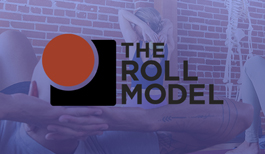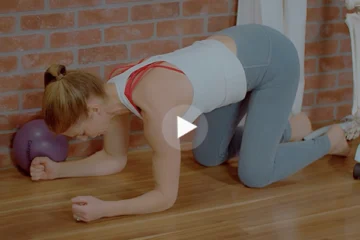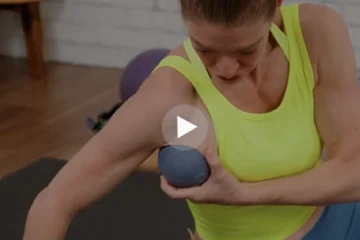

Traditional strength and flexibility work targeting the hamstrings, quadriceps, and gluteals (back and front of the upper legs and hips) providesan important and immediately gratifying fitness routine.At the same time, we often neglect the outer ‘seams’ of our legs and hips when we work out. Unfortunately the commonly experienced soreness or tenderness at the lateral (outside) knee is frequently a direct result of lack of toning and flexibility along the side of our body. To better understand lateral knee pain causes, let’s examine a little known lateral muscle called the tensor fascia latae (TFL), and the long band of tissue that the TFL is encased in: the Iliiotibial (IT) band.
Tensor Fascia Lata (TFL)
The small TFL muscle originates from the iliac crest, just posterior to your anterior superior iliac spine (ASIS). That may sound like a mouthful, but locating the TFL is quite simple as it is a superficial muscle, that is close to the surface of the skin.
First, let’s locate your ASIS. The ASIS, commonly called the hip bones or points, are the bones that you can feel on either side of the front of the hip. Locate them by first manually locating your navel, and then simultaneously drawing your fingers downward at an angle almost to the outer line of your hip. You will run into your ASIS at this point.
Now, if you place the palm of your hand just at the outside and below your ASIS, you’ll discover the location of the TFL. Try doing this while lying down: cross your leg toward the midline of your body with your palm in place as described, and you will immediately feel a solid oval mound in your hand. There it is, the Tensor Fascia Lata!
Your TFL assists in internally rotating and abducting your leg (moving the leg away from the midline of the body).
IT Band and Iliotibial Band Syndrome (ITBS)
The IT band is actually a ribbon of fascial or connective tissue that begins at the hip right behind the ASIS, runs down the side of the thigh like a seam, and inserts on the outside of the knee cap as well as the large shin bone, and a hamstring muscle called biceps femoris.
If you are new to running or cycling, have increased your mileage in those activities, or have perhaps undertaken a new activity such as dancing or stair climbing, you may have experienced pain or burning on the outside of your knee. This could be a sign of ITBS. This discomfort is primarily caused by tension on the IT band which produces repetitive friction on the bony projection of the hip bone (femur). Additionally, weakness in the hip abductor muscles (like the tensor fascia lata) can also effect the tonality of the IT band, causing pain or clicking all the way down to the side of the knee.
If you are experiencing any of the knee pain, burning or clicking described above, it is important to refrain from the physical activity that might have been the trigger for the pain.In addition, icing the knee can provide relief.
I’ll be posting a great Yoga Tune Up® pose called Asymmetrical Uttanasana that works to stretch the IT Band and TFL (and open up the hamstrings while you’re at it!) with my blog post on Wednesday. This yoga therapy exercise also be found on the 10 Minute Quick Fix for Hips video here.
To learn how the Yoga Tune Up® Therapy Ball can be used to stretch and relieve leg and knee pain, check out the following blogs:
The Slimmest Part of Your Knee: It’s Not Just About Hemlines












This was super helpful for me in discovering ways to support firing my glutes more. I never thought of focusing on the TFL to help assist the gluteus muscles.
My IT ban has been giving me trouble lately. I don’t know if i over starched it or my inconsistent running patterns may have been the cause. This read has been very insightful!
Great reminder to give the IT band and tensor fascia lata, (what a fun name to say) some love. I often get tightness or pain along my IT band near my knee. Will look for the next blog post. 🙂
I am so happy to see some explanation of how imbalance of muscles upstream of the knee can be a part of knee problems. I have experienced in my own body how the shortness in the lateral side of the leg is at the root of my knees being internally rotated and therefore in pain or weak. I look forward to reading the post on Asymmetrical Uttanansana.
Thank you Bonnie for such a descriptive blog. I’ve recently discovered that my IT band can’t be stretched, and it blew my mind when I thought back to all these professional classes with instructors claiming to stretch out the IT. It’s such a misconception that I think would be great to bring up in a class and blow their minds too! I hadn’t tried finding the TFL by lying on the floor, I’ll give it a go! Thanks!
I appreciate your description of the knee pain for ITBS, using “burning” as one of the adjectives made a lightbulb turn on for me. I experience this sensation sometimes, I am going to explore my IT band and especially the TFL to see if this pain can be relieved.
Thank you for reading!
Thank you for the clear instructions on how to locate the TFL muscle as well as bringing more clarity to the subject of ITBS and how it relates to knee pain. When people are working with ITBS, where they need to begin stretching and releasing is at the TFL, which will then loosen its grip on the IT band and hopefully provide some relief. Using the YTU balls and Asymmetrical Uttanasana are great ways of doing just that.
The YTU balls are amazing for releasing the ITs and getting through adhesions and are more pinpointed than using a foam roller for certain. How long do you think one should wait to run after releasing these tissues? Or should this be done exclusively after running?
I don’t run but I realise the It band is very affected by the TFL for most of my runner clients. When the TFL tightens, the poor IT band is pulled along for the ride. Pun intended!
Great info on how exactly to locate the TFL & IT bands. I stretch a lot of runners and it’s helpful to have additional information for my clients as well as my own clicking knees. I love foam rollers and YTU balls to help rub out these seriously tight areas.
My IT band has been tight for a long time. So tight, i feel it may snap! but using the balls really gets me the relief I need, which is something I think a lot of people with knee sensitivity can use as well. thanks for the blog post!
Very helpful instructions on locating the TFL and IT band and how their functionality (or lack thereof) manifests. I find for myself that my IT band / TFL are normally just “hanging out” until I try to either (a) release them with YTU therapy balls or a foam roller, or (b) activate them in Abductor lifts (showcasing just how weak and under-toned those muscles are). Luckily, I’ve never had a knee issue, so for me it is just a matter of awareness. Thanks for providing the link to Asymmetrical Uttanasana and for giving all of us the permission to rest and ice rather than always feeling like we must power through.
THis is a great article! Being a runner for so long in my life, it’s amazing how closely connected the hips/knees are to each other. I have had issues with my TFL ever since i completed my first marathon. Now that I know the TFL and IT Band are connected, I will pay special attention to both, so I don’t end up with “runner’s knee”.
I had run 14 road marathons up until my first trail marathon in the Fall of 2010. Needless to say, all the side to side motion of having to jump over streams, large rock and broken tree trunks left my TSL and IT band screaming for the next month. I never realized how imbalanced I was until then and am thankful that I didn’t permanently injure myself in the process. I’ve since then targeted these muscles in my training and am surprised at how much it improves running gait and recovery time from the high impact exercises.
As a long-time runner, cyclist and swimmer, this article really struck me. I really need to pay more attention to gaining a more broad range of motion in my hips especially. To my neglected IT band…I will give you a YTU massage tonight, I promise!
Always good to learn more about the IT band and the importance of stretching/massaging it. This is always a spot that starts to “speak” to me if I don’t tend to it. And it can affect so many other muscles/joints.
This is a great atricle to help identify pain.
Good reminder to massage out our IT band, but oh so tender!
It’s definitely a humbling experience for me to use the Yoga Tune Up balls on my IT band! It’s also a good reminder that I need to give my muscles a little more love.
seems like it would be great to pair stretches of the tensor fascia latae with work on the adductors- with all their attachment points way up on the pubis it’s an area that tends to get neglected; working the two together could help ensure balance in the muscles that sweep the leg through the frontal plane.
Its very useful to learn about anatomy as you begin to become of aware of those underused muscles. I also loved using the tune up balls to massage the IT band!
I love using the yoga tuneup balls to massage the IT band as well!
Today I used the tuneup balls to massage my IT Band. It was amazing how we can forget how much we need to massage all our muscles. I never knew that the IT Band began at the hip right behind the ASIS and runs down the side of the thigh like a seam, and inserts on the outside of the knee cap as well as the large shin bone, and a hamstring muscle called biceps femoris. This is good information.
Despite being new to anatomy, your use of precise language easily helped me to locate my TFL.
This article is very informative. It makes sense how all the muscle groups(it band, hip, knee, thigh, and shin bone) work in harmony. We take for granted how amazing our body is truely connected.
I’ve got some knee pain right now, and this really helps me see how I can fix it. So glad I found this.
Thanks for the clear explaination of the muscles and where the pain could be coming from.
[…] at her side knee was a definite message to back off, and a sign of IT band syndrome described here. After resting and icing the area, her pain began to […]
Excellent article, Bonnie!